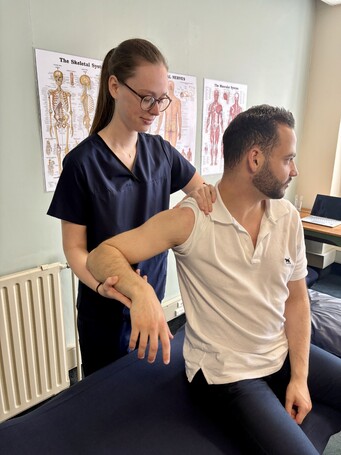Chronic pain is a personal and often invisible struggle. It can affect every aspect of life, from your ability to work and exercise to your mood, relationships, and overall quality of life. Whether it’s persistent neck or back pain, headaches, joint discomfort, or ongoing muscle tension, the impact can be exhausting, frustrating, and, at times, overwhelming.
One highly effective, drug-free approach to managing chronic pain is osteopathy. Osteopathy is a hands-on therapy that takes a whole-body view of health, aiming to identify and treat the underlying causes of your pain, not just the symptoms. Our goal is to help you move better, feel better, and live more comfortably.
What Conditions Can Cause Chronic Pain?
There are many reasons someone may experience chronic pain. Sometimes the cause is clear, such as a past injury or trauma that never fully healed. In other cases, pain develops gradually over time without a specific trigger. Common conditions we see in clinic include:
Arthritis and joint degeneration, including osteoarthritis, which most commonly affect knees, hips, shoulders, and hands.
Chronic low back or neck pain, often due to long-term postural strain, disc issues, or muscle imbalances.
Fibromyalgia, a condition that causes widespread muscle pain and fatigue and is linked to nervous system sensitivity.
Headaches and migraines, particularly those related to neck tension or jaw dysfunction.
Repetitive strain injuries, such as tennis elbow, carpal tunnel syndrome, or shoulder pain from prolonged computer use.
Post-surgical pain or scar tissue restriction, where tissue healing may be “complete”, but pain and stiffness remain.
It’s also common to experience chronic pain following accidents, sports injuries, or periods of high stress or illness, where the nervous system stays in a heightened state long after the original issue has passed.
Whatever the cause, osteopathic treatment is designed to meet you where you’re at and support your body’s natural capacity to heal.
Why Choose Osteopathy for Chronic Pain?
Osteopathy is great for managing chronic pain because it looks at how different parts of the body interact and how lifestyle, posture, previous injuries, and even emotional stress can influence your symptoms.
We understand that no two people experience pain in the same way. That’s why our approach is personalised. We will assess your body’s structure, how you move, areas of restriction or imbalance, and patterns of compensation that may be contributing to your pain.
By using gentle, hands-on techniques, we can help calm the nervous system, reduce muscle tension, improve circulation, and restore more efficient movement patterns. These changes can lead to real improvements in sleep, and energy levels.
As osteopaths, we work closely with you to ensure your needs, preferences, and goals are at the heart of every decision. Your voice matters at every stage of the process, from the initial assessment to shaping your ongoing treatment plan. We’ll discuss all options with you, explain what we’re doing and why, and adapt our approach based on your feedback. Your comfort, consent, and personal priorities will never be disregarded, ensuring that you feel supported, informed, and in control throughout your care journey. We believe that effective treatment comes from partnership.
Supporting Your Recovery Holistically
Our aim isn’t just to ease your symptoms in the moment, but to give you the tools and understanding to support long-term change. Alongside treatment, we’ll work with you on tailored exercises, breathing techniques, and lifestyle advice to help you feel more in control of your body.
If stress or emotional tension is playing a role in your symptoms, we’ll take that into account. Osteopathic treatment can help reduce overactivity in the sympathetic nervous system, the ‘fight or flight’ state, and support the parasympathetic system, the ‘rest and digest’ state, which is essential for healing and recovery.
We also work alongside other complementary practitioners where needed, including massage therapists, acupuncturists, and counsellors, so you have a complete support network to guide your journey.
You Don’t Have to Live with Chronic Pain
If you’ve been living with pain for months or even years, it’s easy to feel like nothing will change. But many people find that with the right support, even long-standing pain can improve.
We’re here to listen, assess, and create a treatment plan that’s right for you. Let us help you break the cycle of pain and rediscover how good your body is designed to feel.
By Dr Francesca Evans Registered Osteopath
Bigal, M.E., Serrano, D., Reed, M. and Lipton, R.B. (2008). Chronic migraine in the population: Burden, diagnosis, and satisfaction with treatment. Neurology, 71(8), pp.559–566. doi:https://doi.org/10.1212/01.wnl.0000323925.29520.e7
Bijlard, E. (2017). A Systematic Review on the Prevalence, Etiology, and Pathophysiology of Intrinsic Pain in Dermal Scar Tissue. January 2018, 1(21;1), pp.1–13. doi:https://doi.org/10.36076/ppj.2017.2.13
Field, B.J. and Swarm, R.A. (2008). Chronic pain. Cambridge, Ma ; Toronto: Hogrefe & Huber
Franke, H., Franke, J.-D. and Fryer, G. (2015). Osteopathic manipulative treatment for chronic nonspecific neck pain: A systematic review and meta-analysis. International Journal of Osteopathic Medicine, 18(4), pp.255–267. doi:https://doi.org/10.1016/j.ijosm.2015.05.003
Johns Hopkins Medicine. (2019). Back and Neck Pain. [online] Available at: https://www.hopkinsmedicine.org/health/conditions-and-diseases/back-pain
Licciardone, J.C. and Gatchel, R.J. (2020). Osteopathic Medical Care With and Without Osteopathic Manipulative Treatment in Patients With Chronic Low Back Pain: A Pain Registry–Based Study. The Journal of the American Osteopathic Association, 120(2), p.64. doi:https://doi.org/10.7556/jaoa.2020.016
Littlejohn, G.O. (1995). Key Issues in Repetitive Strain Injury. Journal of Musculoskeletal Pain, 3(2), pp.25–33. doi:https://doi.org/10.1300/j094v03n02_04
Orrock, P.J. and Myers, S.P. (2013). Osteopathic intervention in chronic non-specific low back pain: a systematic review. BMC Musculoskeletal Disorders, 14(1). doi:https://doi.org/10.1186/1471-2474-14-129
Robinson, A. (2016). Causes and management of chronic pain. Prescriber, 27(7), pp.39–43. doi:https://doi.org/10.1002/psb.1482
SCHAIBLE, H.-G., EBERSBERGER, A. and BANCHET, G.S. (2002). Mechanisms of Pain in Arthritis. Annals of the New York Academy of Sciences, 966(1), pp.343–354. doi:https://doi.org/10.1111/j.1749-6632.2002.tb04234.x
Urits, I., Schwartz, R.H., Orhurhu, V., Maganty, N.V., Reilly, B.T., Patel, P.M., Wie, C., Kaye, A.D., Mancuso, K.F., Kaye, A.J. and Viswanath, O. (2020). A Comprehensive Review of Alternative Therapies for the Management of Chronic Pain Patients: Acupuncture, Tai Chi, Osteopathic Manipulative Medicine, and Chiropractic Care. Advances in Therapy, 38(1), pp.76–89. doi:https://doi.org/10.1007/s12325-020-01554-0
Yunus, M.B. (2012). The Prevalence of Fibromyalgia in Other Chronic Pain Conditions. Pain Research and Treatment, 2012, pp.1–8. doi:https://doi.org/10.1155/2012/584573
To find out more about author Francesca, click here.




